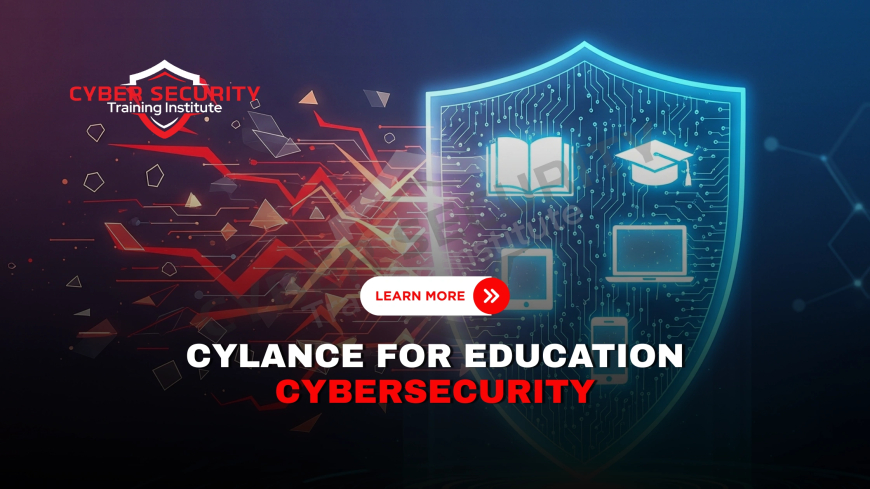Can Cylance Replace Traditional Antivirus in Education Cybersecurity?
Schools and universities are increasingly digital, relying on devices and networks for everything from online classes to student records. But this shift has made them prime targets for cyber threats like viruses, ransomware, and phishing. Traditional antivirus software, which depends on known threat signatures, often struggles to keep up with modern attacks. Cylance, an AI-powered cybersecurity solution, promises a smarter, proactive approach to protect educational institutions. Can it truly replace traditional antivirus in education? This blog explores Cylance’s capabilities, compares it to conventional tools, and evaluates its potential to safeguard digital campuses.

Table of Contents
- Cyber Threats in Education
- What is Traditional Antivirus?
- What is Cylance?
- How Cylance Works
- Cylance vs. Traditional Antivirus
- Benefits of Cylance for Education
- Challenges in Adoption
- Complementary Security Measures
- Real-World Examples
- The Future of Cybersecurity in Education
- Conclusion
- Frequently Asked Questions
Cyber Threats in Education
Educational institutions face a growing array of cyber threats. Schools store sensitive data, like student records and research, and their open networks—used by thousands of students, faculty, and staff—are vulnerable. Recent discussions on X highlight a surge in attacks targeting education, with recovery costs often in the millions.
Common threats include:
- Viruses: Malicious software that corrupts files or systems.
- Ransomware: Locks data, demanding payment to restore access.
- Phishing: Fake emails tricking users into sharing credentials.
- Spyware: Steals sensitive information, like login details.
These threats disrupt learning, compromise privacy, and strain budgets, making robust cybersecurity essential.
What is Traditional Antivirus?
Traditional antivirus software protects devices by scanning for known threats using a database of “signatures”—unique codes of identified malware. When a file matches a signature, the software blocks or removes it. Popular tools like Norton, McAfee, or Windows Defender rely on this approach, requiring frequent updates to stay effective.
Limitations of traditional antivirus include:
- Reactive Nature: Only catches known threats, missing new “zero-day” attacks.
- Frequent Updates: Requires constant signature database updates, taxing IT resources.
- Performance Impact: Can slow devices with heavy scanning processes.
- Limited Scope: Struggles with advanced threats like targeted ransomware.
These weaknesses make traditional antivirus less effective for modern education environments.
What is Cylance?
Cylance is an AI-powered cybersecurity platform that uses machine learning to predict and prevent cyber threats. Unlike traditional antivirus, Cylance doesn’t rely on signatures. Instead, it analyzes file behavior to identify potential malware, even if it’s never been seen before. This makes it ideal for schools with diverse devices and limited IT teams.
Cylance’s key features include:
- Proactive threat prevention using AI.
- Lightweight software for minimal device impact.
- Cloud-based management for easy oversight.
- Protection across multiple devices, like laptops and tablets.
These capabilities position Cylance as a potential replacement for traditional antivirus in education.
How Cylance Works
Cylance uses artificial intelligence to analyze files before they execute, assigning a “threat score” based on their characteristics. If a file’s score indicates potential danger, Cylance blocks it without needing a signature match. It also monitors devices and networks for suspicious activity, providing real-time protection across a school’s digital environment.
Cylance’s process includes:
- Predictive Analysis: Identifies malware based on behavior, not known signatures.
- Real-Time Blocking: Stops threats before they cause harm.
- Low Resource Use: Runs efficiently, even on older school devices.
- Cloud Dashboard: Allows IT teams to monitor threats remotely.
This approach is well-suited for education’s fast-paced, device-heavy settings.
Cylance vs. Traditional Antivirus
The following table compares Cylance to traditional antivirus, highlighting why it may be a better fit for schools:
| Feature | Cylance | Traditional Antivirus |
|---|---|---|
| Threat Detection | Uses AI to predict and block unknown threats. | Relies on known threat signatures. |
| Update Frequency | Minimal updates needed; AI adapts automatically. | Requires frequent signature updates. |
| Performance Impact | Lightweight, low impact on devices. | Can slow devices with heavy scanning. |
| Scalability | Scales easily for large school networks. | Scalability varies by product. |
| Response to New Threats | Proactively stops zero-day attacks. | Struggles with unknown threats. |
Cylance’s AI-driven approach offers clear advantages over traditional antivirus, especially in education’s dynamic environments.
Benefits of Cylance for Education
Cylance provides significant advantages for schools and universities:
- Proactive Defense: Stops new threats before they strike, unlike signature-based tools.
- Efficiency: Reduces IT workload with minimal updates and cloud management.
- Performance: Runs smoothly on student and faculty devices, even older ones.
- Data Protection: Safeguards sensitive information, ensuring compliance with laws like FERPA.
- Cost Savings: Prevents costly breaches and recovery efforts.
These benefits make Cylance a compelling alternative to traditional antivirus in education.
Challenges in Adoption
While Cylance is powerful, schools face challenges in adopting it:
- Cost: Licensing fees may strain tight education budgets.
- Technical Setup: Requires expertise to configure and integrate with existing systems.
- Transition Period: Switching from traditional antivirus can involve downtime or retraining.
- False Positives: AI may flag legitimate files as threats, needing human review.
- Dependency on AI: Over-reliance may neglect other security practices.
Schools must weigh these challenges and plan for a smooth transition.
Complementary Security Measures
Cylance is most effective when paired with other defenses:
- User Training: Educate students and staff on avoiding phishing and risky downloads.
- Multi-Factor Authentication (MFA): Add extra login security to prevent unauthorized access.
- Regular Backups: Store data offline to recover from attacks without loss.
- Firewalls: Block malicious traffic to protect school networks.
- Software Updates: Patch systems to close vulnerabilities.
These measures enhance Cylance’s ability to secure educational environments.
Real-World Examples
Cylance has shown success in educational settings, as noted in recent cybersecurity discussions:
- A U.S. school district blocked a ransomware attack on student devices using Cylance’s AI, saving critical data.
- A UK university reduced malware incidents by 85% after replacing traditional antivirus with Cylance.
- An Australian college stopped a zero-day virus, protecting online exams with Cylance’s predictive defense.
These cases demonstrate Cylance’s potential to outperform traditional antivirus in education.
The Future of Cybersecurity in Education
As cyber threats evolve, AI-driven tools like Cylance will shape education cybersecurity:
- Advanced AI: Improved algorithms to detect sophisticated threats with fewer false positives.
- IoT Security: Protecting smart classroom devices, like interactive boards.
- Automated Response: AI-driven recovery from attacks without human intervention.
- Zero Trust Models: Verifying every user and device to enhance security.
Cylance’s proactive approach positions it to lead this evolution, offering schools long-term protection.
Conclusion
Cylance’s AI-powered cybersecurity offers a compelling alternative to traditional antivirus in education, addressing the limitations of signature-based tools with proactive, predictive defense. By stopping unknown threats, minimizing updates, and running efficiently, Cylance meets the needs of schools with diverse devices and limited IT resources. While challenges like cost and setup complexity exist, combining Cylance with user training, backups, and other defenses creates a robust security framework. As cyber threats grow more sophisticated, Cylance’s ability to adapt and protect makes it a strong candidate to replace traditional antivirus, ensuring safe digital learning environments for students and faculty.
Frequently Asked Questions
What is traditional antivirus?
It’s software that uses known threat signatures to detect and remove malware, like viruses.
How does Cylance differ from traditional antivirus?
Cylance uses AI to predict and block unknown threats, unlike signature-based antivirus.
Why do schools need cybersecurity?
They store sensitive data and use digital tools, making them targets for malware and phishing.
Can Cylance stop new viruses?
Yes, its AI predicts and blocks zero-day threats without needing signature updates.
Is Cylance suitable for small schools?
Yes, its scalable, cloud-based design fits schools of all sizes.
What is ransomware?
Ransomware locks data, demanding payment to restore access, disrupting education.
Does Cylance slow down school devices?
No, its lightweight design ensures minimal impact on performance.
How does Cylance protect student data?
It blocks malware and unauthorized access, ensuring compliance with laws like FERPA.
Can Cylance replace all antivirus software?
It can replace traditional antivirus but works best with complementary defenses.
What is a zero-day attack?
It’s a new, unknown threat that traditional antivirus struggles to detect.
Is Cylance expensive for schools?
It may require investment, but cloud options and grants can reduce costs.
How does Cylance help IT teams?
It automates threat detection and management, easing the workload for small teams.
What is multi-factor authentication (MFA)?
MFA requires multiple verification steps to secure logins, reducing risks.
Can user training complement Cylance?
Yes, educating users on safe practices lowers the risk of malware infections.
What is a data breach?
It’s when hackers access sensitive data, like student records, often via malware.
How fast does Cylance respond to threats?
It blocks threats in real time, preventing damage to school systems.
Can Cylance detect phishing?
While focused on malware, it complements anti-phishing tools by blocking malicious downloads.
What are false positives in cybersecurity?
They’re when legitimate files are flagged as threats, requiring human review.
Can Cylance protect older devices?
Yes, its lightweight design works well on older school computers.
How will cybersecurity evolve in education?
Future solutions will use advanced AI, secure IoT devices, and automate responses.
What's Your Reaction?
 Like
0
Like
0
 Dislike
0
Dislike
0
 Love
0
Love
0
 Funny
0
Funny
0
 Angry
0
Angry
0
 Sad
0
Sad
0
 Wow
0
Wow
0







![How to Install RHEL 10 on VMware/VirtualBox [Tutorial]](https://www.cybersecurityinstitute.in/blog/uploads/images/202509/image_430x256_68b56dc967a4a.jpg)









